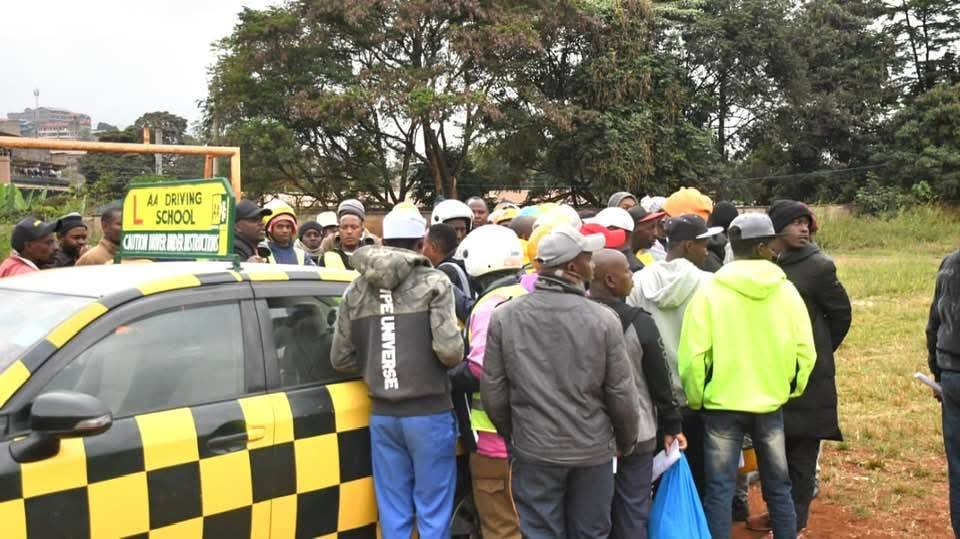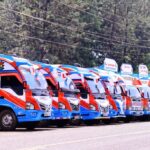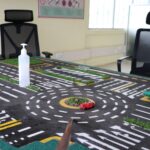Navigating the roads of Kenya requires not just practical driving skills but also a deep understanding of traffic rules and road networks. For aspiring drivers, the National Transport and Safety Authority (NTSA) driving exam is a critical milestone in obtaining a valid driving license. A key component of this exam is the Model Town Board, a scaled-down representation of real-world road networks used to test a learner’s knowledge of traffic rules, road signs, and navigation skills. Mastering the Model Town Board is essential for passing the NTSA driving test, as it evaluates how well candidates can apply theoretical knowledge to simulated traffic scenarios.
In this comprehensive guide, we explore the Model Town Board, its purpose, key features, and the most common questions asked during the NTSA driving exam in 2025. Whether you’re a learner driver enrolled in a driving school or preparing for your test, this article provides actionable insights, practical tips, and answers to frequently asked questions to help you pass with confidence. Let’s dive into everything you need to know about the NTSA Model Town Board and how to ace this critical part of the driving exam.
What is the Model Town Board?
The Model Town Board is a teaching tool used in Kenyan driving schools to simulate real-life traffic situations found in urban and rural road networks across Kenya and East Africa. It is a physical or digital representation of a road system, complete with features like one-way roads, two-way roads, roundabouts, pedestrian crossings, parking zones, and traffic signs. The board is designed to help learners understand how to navigate complex road scenarios, adhere to traffic rules, and prioritize road safety.
According to the NTSA, the Model Town Board is a core component of the driving exam because it tests a candidate’s ability to interpret road signs, maintain lane discipline, and make safe driving decisions. During the exam, candidates are often asked to move a toy car across the board to demonstrate their understanding of traffic flow, parking rules, and right-of-way protocols. Mastering this section is crucial, as it accounts for a significant portion of the theory test, which, combined with the practical test, requires an overall pass mark of 80%.
Key Features of the Model Town Board
The Model Town Board includes several elements that mirror real-world road networks. Understanding these components is the first step to excelling in the NTSA driving exam:
- One-Way Traffic Roads: Streets where vehicles travel in a single direction, often marked with continuous or broken white lines.
- Two-Way Traffic Roads: Roads allowing traffic in opposite directions, typically marked with yellow lines.
- Roundabouts: Circular intersections where vehicles move clockwise around a central island.
- Pedestrian Crossings: Designated areas for pedestrians to cross safely, often marked with zebra stripes.
- Parking Zones: Areas for angle or flush parking, with specific rules for entry and exit.
- Traffic Signs: Including stop signs, give-way signs, and no-parking signs.
- Road Markings: Such as continuous lines (no overtaking) and broken lines (overtaking allowed if safe).
- Yellow Kerbs: Indicate areas where parking or stopping is prohibited.
By familiarizing yourself with these features, you’ll be better equipped to answer Model Town Board questions during the NTSA driving exam.
Why the Model Town Board Matters in the NTSA Driving Exam
The NTSA driving exam is designed to ensure that drivers are competent and safe on Kenyan roads. The Model Town Board is a critical tool because it bridges the gap between theoretical knowledge and practical application. It tests a candidate’s ability to:
- Interpret and follow road signs and markings.
- Navigate complex road layouts, such as roundabouts and junctions.
- Apply lane discipline and prioritize right-of-way.
- Execute proper parking techniques in various scenarios.
- Understand traffic flow and avoid common mistakes.
Failing to master the Model Town Board can result in deductions during the exam, lowering your chances of achieving the required 80% pass mark. Additionally, the skills learned through the Model Town Board are directly applicable to real-world driving, making it an essential part of driver training in Kenya.
Common Model Town Board Questions and Answers
The NTSA driving exam includes a variety of questions related to the Model Town Board. These questions often involve moving a toy car to a specific location on the board while adhering to traffic rules. Below are some of the most common Model Town Board questions and their answers, compiled from credible sources and driving school curricula in 2025.
1. What Are the Rules of the Model Town Board?
Understanding the fundamental rules of the Model Town Board is critical for success. These rules guide how you navigate the board during the exam:
- Use the Shortest Route: Always choose the shortest and most correct route to your destination without using parking areas unless necessary.
- Use the Longest Route if Required: If the shortest route is blocked or incorrect, use the longest correct route without parking.
- Parking as a Last Resort: Only use parking zones when no other route is available.
- Give Way at Roundabouts: Always yield to vehicles coming from the right in a roundabout.
- Park from the Furthest Side: When parking, enter from the furthest side of the parking zone to ensure proper alignment.
Example Question: What is the most important rule when navigating the Model Town Board?
Answer: Always use the shortest and most correct route without using the parking area unless it’s the only option.
2. How Do You Navigate a One-Way Traffic Road?
One-way roads are common on the Model Town Board and in real-life Kenyan towns. These roads are marked with specific lines that dictate driver behavior.
- Continuous White Line: No lane changing or overtaking is allowed.
- Broken White Line: Lane changing or overtaking is permitted if the road is clear.
- Yellow Kerb: Indicates no parking or stopping.
Example Question: On a one-way road with a continuous white line, what is the correct procedure if you want to change lanes?
Answer: You must not change lanes, as the continuous white line prohibits lane changes.
3. How Do You Approach a Roundabout?
Roundabouts are a focal point of the Model Town Board, as they test lane discipline and right-of-way knowledge.
- Approach in the Correct Lane: Choose the lane based on your intended exit.
- Yield to Traffic from the Right: Vehicles already in the roundabout have priority.
- Do Not Stop or Change Lanes: Maintain your lane and avoid stopping inside the roundabout.
- Exit Correctly: Signal and exit into the appropriate lane.
Example Question: What is the correct procedure when approaching a roundabout?
Answer: Approach in the correct lane, yield to traffic already in the roundabout, and enter when safe.
4. What Are the Rules for Parking Zones?
Parking is a critical skill tested on the Model Town Board. The board includes two main types of parking:
- Angle Parking:
- Used for small vehicles like saloon cars.
- Park in forward gear, exit by reversing.
- Flush Parking:
- Parallel to the curb, suitable for most vehicles except heavy ones.
- Park by reversing, exit by driving forward.
Example Question: When using flush parking, what is the correct way to park and exit?
Answer: Park by reversing into the spot and exit by driving forward.
5. What Should You Do at a Stop Sign?
Stop signs are critical for ensuring safety at intersections.
- Stop Completely: Come to a full stop at the stop line.
- Check Both Directions: Look left, right, and left again before proceeding.
- Proceed When Safe: Only move when the road is clear.
Example Question: At a stop sign, what should you do?
Answer: Stop, check both directions, and only proceed when it is safe.
6. How Do You Respond to a Give-Way Sign?
The give-way (yield) sign, a red downward-pointing triangle, requires drivers to prioritize other traffic.
- Slow Down or Stop: Reduce speed and stop if necessary to allow other vehicles to pass.
- Proceed When Safe: Move forward only when the road is clear.
Example Question: What should you do when you approach a give-way sign?
Answer: Slow down or stop if necessary and proceed when safe.
7. What Are the Formulas for Major and Minor Roads?
Some NTSA exams may include questions about specific navigation patterns or “formulas” for major and minor roads on the Model Town Board.
- Major Road Formula: Starting from the left, follow the sequence 2, 1, 2, 4.
- Minor Road Formula: Starting from the left, follow the sequence 2, 1, 5.
Example Question: What is the formula for navigating a major road on the Model Town Board?
Answer: Starting from the left, the sequence is 2, 1, 2, 4.
Common Mistakes to Avoid on the Model Town Board
Even well-prepared candidates can make errors during the NTSA driving exam. Here are some common mistakes and how to avoid them:
- Incorrect Lane Choices at Roundabouts: Always approach a roundabout in the correct lane based on your intended exit. Practice lane discipline to avoid confusion.
- Ignoring Traffic Signs: Pay close attention to stop signs, give-way signs, and no-parking zones to avoid penalties.
- Improper Parking: Follow the specific rules for angle and flush parking, ensuring you enter and exit correctly.
- Overtaking in Prohibited Zones: Never overtake on roads with continuous lines or in areas marked as no-overtaking zones.
- Failing to Yield: Always give way to vehicles from the right at roundabouts and junctions.
How to Prepare for Model Town Board Questions
Preparation is key to mastering the Model Town Board and passing the NTSA driving exam. Here are practical tips to help you succeed:
- Study the Highway Code: The Kenyan Highway Code is a comprehensive guide to road rules and signs. Familiarize yourself with its contents, as it forms the foundation of the exam.
- Practice with Model Town Board Simulations: Many driving schools and online platforms like Caaradar offer interactive Model Town Board practice. Use these tools to simulate exam scenarios.
- Take Practical Driving Lessons: Hands-on experience with an instructor will help you apply Model Town Board concepts to real-world driving.
- Memorize Key Rules: Focus on the rules for roundabouts, parking, and right-of-way, as these are frequently tested.
- Understand Road Markings: Learn the meanings of continuous and broken lines, yellow kerbs, and other markings to avoid mistakes.
- Stay Calm During the Exam: The Model Town Board test can be nerve-wracking, but staying composed will help you think clearly and answer accurately.
Additional NTSA Driving Exam Tips
Beyond the Model Town Board, the NTSA driving exam includes a practical component and other theoretical questions. Here are some additional tips to boost your overall performance:
- Know General Traffic Rules:
- The rule of the road in Kenya is to keep left unless overtaking.
- The maximum speed limit in town is 50 km/hr, while on highways, it’s 110 km/hr for cars, 80 km/hr for pick-ups and lorries, and 65 km/hr for trailers.
- Understand Vehicle Requirements:
- Carry a valid driving license, insurance certificate, and vehicle inspection certificate.
- Essential tools for a safari include a car jack, spare wheel, spotlight, and fire extinguisher.
- Be Aware of Road Safety:
- Report accidents to a police station within 24 hours.
- Avoid driving when sick, drunk, or fatigued, even with valid documents.
- Master Road Signs:
- Warning signs are triangular, regulatory signs are circular, and informational signs are rectangular.
The Role of Driving Schools in Preparing for the Model Town Board
Enrolling in a reputable driving school is one of the best ways to prepare for the NTSA driving exam. These institutions provide hands-on practice with the board, ensuring you understand how to navigate complex scenarios. Additionally, many schools offer online resources and mock tests to simulate the exam environment.
When choosing a driving school, look for one that:
- Is registered with the NTSA.
- Offers comprehensive Model Town Board training.
- Has experienced instructors who emphasize road safety.
- Provides access to practice materials and simulations.
The Model Town Board is a cornerstone of the NTSA driving exam, designed to test your ability to navigate Kenyan roads safely and efficiently. By understanding its key features, memorizing the rules, and practicing common questions, you can approach the exam with confidence. From mastering roundabouts to executing proper parking techniques, the skills learned through the Model Town Board will serve you well on the road.
To pass the NTSA driving exam in 2025, combine diligent study of the Highway Code with hands-on practice at a reputable driving school. Avoid common mistakes, stay calm during the test, and apply the knowledge gained from this guide. With the right preparation, you’ll be on your way to earning your driving license and becoming a confident, road-wise driver in Kenya.
Ready to take the next step? Enroll in a certified driving school, practice with online Model Town Board simulations, and review the questions and answers provided in this article. Your journey to mastering the NTSA driving exam starts now!





